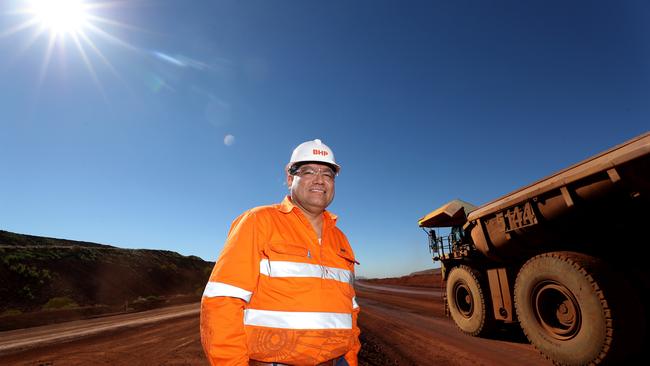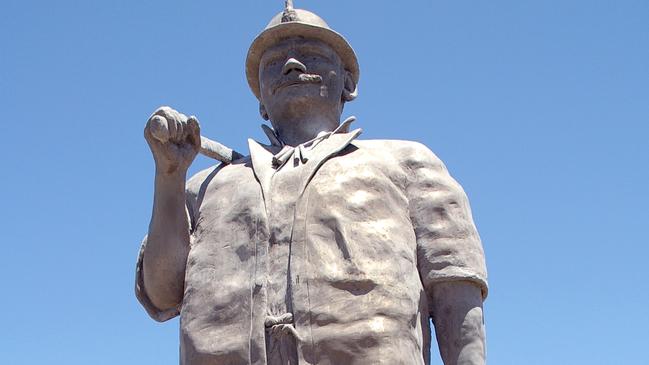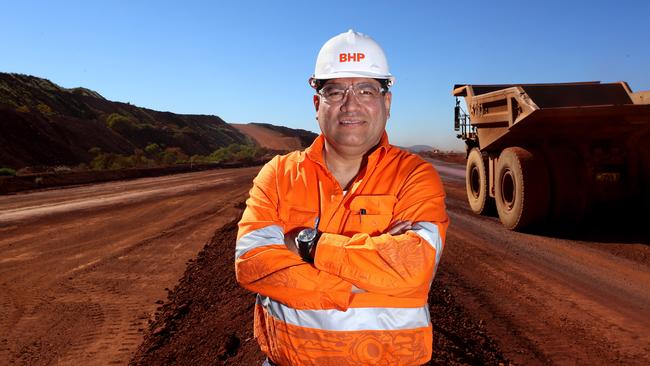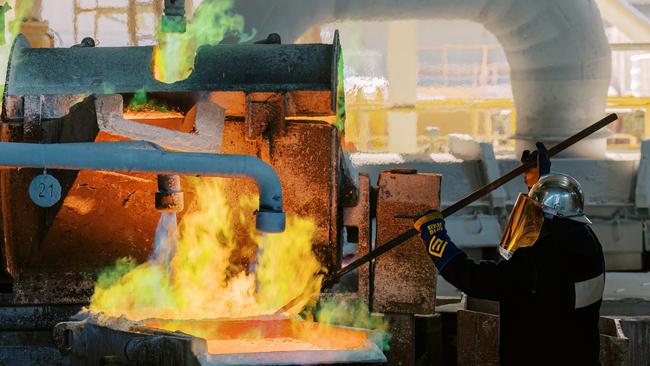SPECIAL REPORT: BHP’s $6bn bet to make SA a global green energy force
Global mining giant BHP is betting billions that SA’s stockpile of copper is about to create a massive new windfall. And the state’s bottom line is set to benefit as a result.
SA News
Don't miss out on the headlines from SA News. Followed categories will be added to My News.
Mining giant BHP believes SA can become one of the world’s biggest copper producers, with the potential to eventually produce as much as $6 billion worth of red metal each year to help satisfy surging global demand for electric vehicles and more renewable energy.
BHP is on track to produce about 315,000 tonnes of copper this year from Olympic Dam in the state’s far north, plus its recently acquired Oz Minerals mines at Prominent Hill and Carapateena.
In an indep piece with SA Weekend (below), BHP chief operating officer Edgar Basto said the company expected this to rise to 500,000 tonnes, but did not place a timeframe on that prediction. At today’s price of about $12,000 a tonne, this would equate to $6 billion, but experts predict prices to rise.
“Because this (SA) is a very stable jurisdiction, the more I look at the potential synergies and what we have done in Olympic Dam over the last few years, (I am) more and more than optimistic that we’re going to be able to get there,” he said.
BHP also has high hopes for its Oak Dam project, 65km south east of Olympic Dam, which received exploration approval in March.
Mr Basto outlined the bigger picture as creating a “world-class copper district” in South Australia, made up of Olympic Dam, Prominent Hill, Oak Dam and Carrapateena which all lie within a geological zone known as the Gawler Craton.
Earlier this year, BHP finalised its $9.6 billion takeover of the Adelaide-based Oz Minerals, which housed Carapateena and Prominent Hill.
The South Australia government can also expect to benefit from the increased production through soaring royalty payments. BHP paid about $102 million in royalties to the SA government in 2022, while Oz Minerals contributed $63.2 million.
If BHP achieves 500,000 tonnes of copper production, and the metal’s price increases as predicted in coming years by investment bank Goldman Sachs which has forecast the world will need between 600 per cent and 900 per cent more copper by 2030, the state government could double current royalty receipts.
The demand for copper is being driven by its property as a conductor of electricity and the global move towards EVs.
BHP is also planning to expanding its copper smelter at Olympic Dam and is in negotiations with the state government about contributing to the economic impact statement for a proposed Northern Water Supply Project that could pump water from a desalination plant near Whyalla.
It is expected the EIS alone will cost around $230 million and Treasurer Stephen Mullighan said this week that an undeclared amount had been set aside for the project.
So how has this all come to pass, and what does it mean for South Australia?

When you drive into the small town of Kapunda, from its southern side, he’s hard to miss. There, standing 7m high in cast bronze, is Map the Miner with his helmet and pick. Also known as Map Kernow, the giant statue is telling visitors that Kapunda is a mining town.
Kapunda sits between the Barossa and Clare valleys and mining was once big in these parts. For more than 30 years in the 1800s, mainly Cornish miners dug the red metal out of the earth around Kapunda.
It was discovered by Captain Charles Bagot in 1842 and two years later mining began. This was the first metal mining operation in Australia.
On the edges of the town, the old mine workings are still there. They have been turned into a tourist attraction and the distinctive green copper oxide still marks the rocks and the water.
In those early days, the copper mines at Kapunda, and at places such as Burra, Wallaroo and Moonta, were all that stood between South Australia and bankruptcy.
For a while, South Australia was the biggest copper producer in the British Empire. At least until the copper market collapsed in the late 1870s and the mines closed.
More than 150 years after that heyday, it turns out what’s old is new again.
BACK TO THE FUTURE
There are now some who believe copper is back in South Australia and are throwing billions of dollars at the idea that the state can again be a global force.
As the chief operating officer of mining behemoth BHP Edgar Basto is fond of saying: “Here in South Australia we have nearly 70 per cent of Australia’s copper resources but we produce just under 30 per cent of Australia’s mined copper production.’’
And Australia has the second-biggest amount of copper in the world. It’s a big deal for the state and a big deal for the country.
The optimism is driven by the theory that as the world moves ever faster towards decarbonisation and electrification, there is no more precious resource than copper.
Copper, you see, is an excellent conductor of electricity and along with minerals such as lithium cobalt and nickel, will be the vital ingredient as electric vehicles take over, renewable energy becomes the norm and the world seeks to achieve net zero climate change targets by 2050.
The good news for South Australia and, in turn, the rest of the country, as BHP’s Basto points out, is that this state still has a fair bit of copper sitting in the ground.
It wasn’t all dug up in the 1800s.
We’ll come back to BHP in more depth later. They are impossible to ignore in this story.
But the world’s thirst for copper is why a company such as EnviroCopper has spent the past eight years in Kapunda trialling a new method of extraction that will potentially revive a mine that closed in 1879.
EnviroCopper is not alone. Copper will soon be mined again by Hillgrove Resources near Kanmantoo in the Adelaide Hills. Rex Minerals is pursuing a mine near Ardrossan on the Yorke Peninsula.
Then there is BHP.
For so long BHP has been billed as an economic saviour for South Australia based on the seemingly massive potential of its Olympic Dam mine, with its rich resources of uranium, gold, silver and copper.
Yet, it never seemed quite to live up to all the promises it made.
But now BHP has spent almost $10bn buying the South Australian-based Oz Minerals, which has two mines close to Olympic Dam, and executives such as Basto are talking of building a “world-class copper district” and digging up 500,000 tonnes of the stuff a year.
It’s possible the copper stars are aligning.
The South Australia government can also expect to benefit from this increased production through soaring royalty payments. BHP paid around $102 million in royalties to the SA government in 2022, while Oz Minerals contributed $63.2 million. If BHP achieves 500,000 tonnes of copper production, and the metal’s price increases as predicted in coming years by investment bank Goldman Sachs which has forecast the world will need between 600 per cent and 900 per cent more copper by 2030, the state government could double current royalty receipts.
Not only is more copper than ever required, the predictions are that supply will not be able to keep up with demand. Market forces then tell you the price of copper will then rise, with some expecting it to almost double before the end of this decade.

MINE WITH A DIFFERENCE
Tapping into this expected boom is what is driving husband and wife team Philippa and Leon Faulkner. Leon is a geologist and managing director of EnviroCopper, while Philippa is business development manager. Their office on the main street in Kapunda sits in the town’s old school of mines building.
They have been here since 2017 – a source of frustration for the Faulkners is that nothing in the mining industry happens in a hurry – but if all goes well they will be pulling copper out of the ground by 2026.
But this will not be a regular mine. No big holes. No big explosions. Just some white pipes poking out of the ground. Which, with the town of Kapunda right there, is a definite advantage.
“There’s been lots of companies over the years, since the 1970s or ’80s, who have looked at making this another conventional mine,’’ Leon says, before looking out the window.
“Which means the pit would be all this main street, up to the schools, takes all the pubs out; yeah, doesn’t fly, probably never going to happen.”

EnviroCopper uses a process called in situ recovery. It’s a technique used in uranium mines in the state’s north. It involves pumping a light acid solution through the porous rocks which dissolves the copper and then the liquid is pumped back up to the surface through bores or wells and then the metal is recovered.
Philippa says the nature of the mining has helped win over the local community.
“There will always be someone that won’t want it, of course, but it’s low impact, it’s environmentally friendly, it’s socially acceptable,” she says.
If it works as expected – and the science is being supported by the CSIRO and Adelaide University – the Faulkners say it could possibly be widely used in other sensitive areas and become a replacement for traditional mining methods.
They are also looking at a site on the Yorke Peninsula, which sits under current farming land. The battle between farmers and miners for access to land has been a point of contention around the world for many years.
“So, it’s not farming or mining, we can actually go out, recover the copper, and the farmer can be farming away at the same time. And when we’re finished, he gets his paddock back and everyone’s happy,’’ Leon says.
The Faulkners believe they could extract between 80,000 and 100,000 tonnes of copper from Kapunda.
GLOBAL PRICE SPIKE FORECAST
The current price of copper is around $US8300 a tonne. Crude maths says that resource could be worth about $US830m ($1.2bn), which is what makes all this effort worthwhile. And it is expected the price is only going to go up.
Last December, investment bank Goldman Sachs predicted the copper price would reach $US11,000 a tonne this year, while demand for copper would exceed supply by 178,000 tonnes. It says $US15,000 a tonne by the end of the decade is possible.
In another report, Goldman Sachs explained its thinking is based on the assumption that there will be “no decarbonisation without copper”.
It also predicts that by 2030 demand for the metal will have grown between 600 per cent and 900 per cent, depending on how quickly the world transitions to a net zero economy. The quicker the transition, the greater the thirst will be for copper.
“As the most cost-effective conductive material, copper sits at the heart of capturing, storing and transporting these new sources of energy,” Goldman Sachs wrote.
“In fact, discussions of peak demand overlook the fact that without a surge in the use of copper and other key metals, the substitution of renewables for oil will not happen.”
The numbers back up that optimism.
Electric cars need between 60kg and 83kg of copper. That is around four times the amount required in a car powered by an internal combustion engine. The charging ports also need copper of between 1kg and 7kg. A fast DC charger can contain up to 25kg.
Electric car sales increased by 60 per cent last year to pass 10 million globally for the first time, making up about 14 per cent of the market.
Some are predicting as many as 60 per cent of all new car sales will be electric by 2030 and close to 100 per cent by 2050.
Solar panels and wind turbines also require a stack of copper. A 3MW wind turbine is powered by as much as 4.7 tonnes of copper.
BHP DOUBLES DOWN
No one in the world has access to more copper than BHP. Of all the miners globally, BHP claims to have the biggest “endowment” of the metal. Among others, it owns the massive Escondida mine in Chile, which Edgar Basto presided over for many years.
Basto has also run BHP’s iron ore operations in Western Australia’s Pilbara region and in his current incarnation as the company’s chief operating officer is responsible for copper in South Australia.
His most pressing concern is bedding down BHP’s $9.6bn acquisition of Oz Minerals. The Adelaide-headquartered Oz Minerals was a great mining success story and operated two copper mines in the far north of South Australia at Prominent Hill and Carrapateena.
It was a company with a reputation for innovation and efficiency.
BHP, on the other hand has, on occasion, built up expectations on expanding Olympic Dam with multibillion-dollar investments, only to change its mind. It canned a planned $20bn expansion of Olympic Dam in 2012, embarrassing the then Labor state government which had pinned all its economic hopes and dreams on the project going ahead.
It has led some, including now Labor Premier Peter Malinauskas, to acknowledge that “there are different views about whether or not the BHP acquisition of Oz Minerals is in the state’s interest’’.

Basto says he has heard the concerns but says part of the reason to buy Oz Minerals was to learn from them.
“We’re putting that together (the combination of the companies) under my accountability with the intent to exactly address the point that you mentioned – are there opportunities where we can learn to be agile, or we can improve?” he says.
But the Colombian-born Basto also makes the point that BHP hasn’t been standing still at Olympic Dam, spending hundreds of millions of dollars in recent years to improve the facility.
He is also a natural enthusiast. He says BHP’s decision to buy Oz was driven by its philosophy to concentrate on “future facing commodities”. He outlines the bigger picture as creating a “world-class copper district” in South Australia.
Olympic Dam, Prominent Hill and Carrapateena all lie within a geological zone known as the Gawler Craton.
As does Oak Dam, which is only about 35km from Carrapateena, a mine in the development phase for which BHP also has high hopes.
Basto believes the combination of all the mines will allow a sharing of resources and infrastructure that will benefit all of the operations. He talks of creating a “mining hub”.
“We need to develop Oak Dam therefore, you have already an operation which is Carrapateena, which is very close, and it will enable us to develop Oak Dam in a very efficient and effective way,’’ he says.
BHP also has longer-term plans to upgrade its smelter at Olympic Dam to process the ore from the Oz mines and, all being well, Oak Dam.
BIG HAULS, BIGGER BUCKS
Certainly, the numbers look huge.
Olympic Dam will produce as much as 200,000 tonnes of copper this year, with another 115,000 tonnes expected from the Oz Minerals mines. In a recent address in the US, BHP chief executive Mike Henry said he expected the total to reach 500,000 tonnes a year, although he did not put a time frame on when that number could be reached. It’s a target that Basto says he is comfortable with.
“Because this is a very stable jurisdiction, the more I look at the potential synergies and what we have done in Olympic Dam over the last few years, (I am) more and more than optimistic that we’re going to be able to get there,” he says.
A crucial factor for BHP, and one familiar to all South Australians, is the question of water supply. Copper mining and smelting uses a lot of water and BHP taps into the Great Artesian Basin for its supplies, which is not an environmentally sustainable proposition in the long run as the size of the operation grows.
The company is talking to the state government about what’s known as the Northern Water Supply Project. This would involve building a desalination plant in the upper Spencer Gulf near Whyalla, and then a pipeline to pump the water into the far north of the state. To places like Olympic Dam.

If approved it will be a multi-billion dollar project. The state government is currently considering a business case on the NWSP and contemplating whether to proceed with a full environmental impact statement – a piece of work that by itself will cost around $230m. It’s not a cost that government will bear alone. Basto acknowledges BHP will have to make a substantial contribution as well.
Premier Peter Malinauskas still harbours a few doubts about BHP. At a recent speech in Adelaide to the Committee for Economic Development of Australia, Malinauskas, referring to previous unfulfilled expectations, quipped that the miner had “left other premiers at the altar before” and wanted a “pre-nup”, presumably before consummating the deal.
Sitting in his office in Parliament House, Malinauskas says: “We’re approaching the process cautiously, as they are, and they are conscious of that”.
“We acknowledged with BHP that if it did go ahead, they would be beneficiaries of that (pipeline), but so would the state, and it’s about sharing the risk of the project and the costs, and it’s about getting that balance right between the various parties that’s important.”
The Premier is keen to keep “expectations” under control to some extent but it’s also not too difficult to read his enthusiasm for what he sees as the potential benefits a reliable water supply could bring to the north of the state. He compares the NWSP to the pipeline built in the 1930s under the government of Thomas Playford, that took water from the Murray to Whyalla and made the steel industry a reality.
“If we can get the water piece addressed again in the future, that opportunity exists again,” he says.
This is the grand plan Malinauskas is sketching. The water project is one part. The $600m hydrogen plant, also near Whyalla, is another. And there is the existing steel plant in Whyalla.
Then there is the abundance of solar and wind power. Then there is also the potential to mine the state’s undeveloped iron ore resources.
Then, the theory is, South Australia becomes a centre for green copper and green steel production at the very time the world is crying out for such products.
As an aside, the cheaper energy available from hydrogen, sun and wind also attracts a whole heap of other businesses to South Australia.
It also fits into another current buzzy acronym in the mining industry – ESG. ESG stands for environmental, social and governance. It’s about presenting a statement of corporate social responsibility and framing the mining industry as a responsible environmental citizen. It’s the kind of thinking that has a company such as BHP trialling battery technology on even its biggest mining vehicles in an effort to cut down on diesel emissions.
Still, the water element may be the most critical in the Malinauskas dream ultimately being realised.
“There will always be the copper mining opportunity, and there’s the opportunity to expand that,” Malinauskas says.
“But if we want to go further than just mining the copper and seeing more processing of it, we do need more water. But related to all that is also we need it for hydrogen, mass grid scale. Gigawatt-scale hydrogen production is going to require more water.”
HEADING FOR THE HILLS
Up in the Adelaide Hills, Lachlan Wallace is preparing to run Australia’s newest copper mine. Wallace is managing director of Hillgrove Resources, which mined an area near Kanmantoo for a decade until 2019. Then it was an open-cut mine, and about 137,000 tonnes of copper and 55,000 ounces of gold were dug out.
What’s left behind is a spectacular 360m-deep hole in the ground and a change by Hillgrove to become an underground miner, making it more efficient to extract the copper that is still there. Wallace says continuing as an open cut mine had become uneconomic.
There were also environmental challenges. The local Kanmantoo township is only 1km away and that is another factor.
“Expectations within the community have changed,” he says. “And I think getting open pits permitted close to high density residential areas is probably more of a challenge than what it was 15 years ago. However, that being said, we have an excellent relationship with the community.”

The move to underground was possible after a $38m fund raising effort for the stock exchange-listed company and Wallace believes there is at least another 45,000 tonnes of copper that will be extracted, and possibly more.
The plan is to start selling copper from early next year, placing Hillgrove ahead of many other companies who are still on the long regulatory road that is required before a mine is up and running.
Wallace believes South Australia can capitalise on its status as a stable political jurisdiction (unlike other copper-rich but more volatile countries in South America and Africa), which is broadly mining friendly.
“It really positions South Australia – which is well endowed with copper in a tier one jurisdiction – to be the pre-eminent copper supplier to the world,” he says.
More Coverage
Originally published as SPECIAL REPORT: BHP’s $6bn bet to make SA a global green energy force



